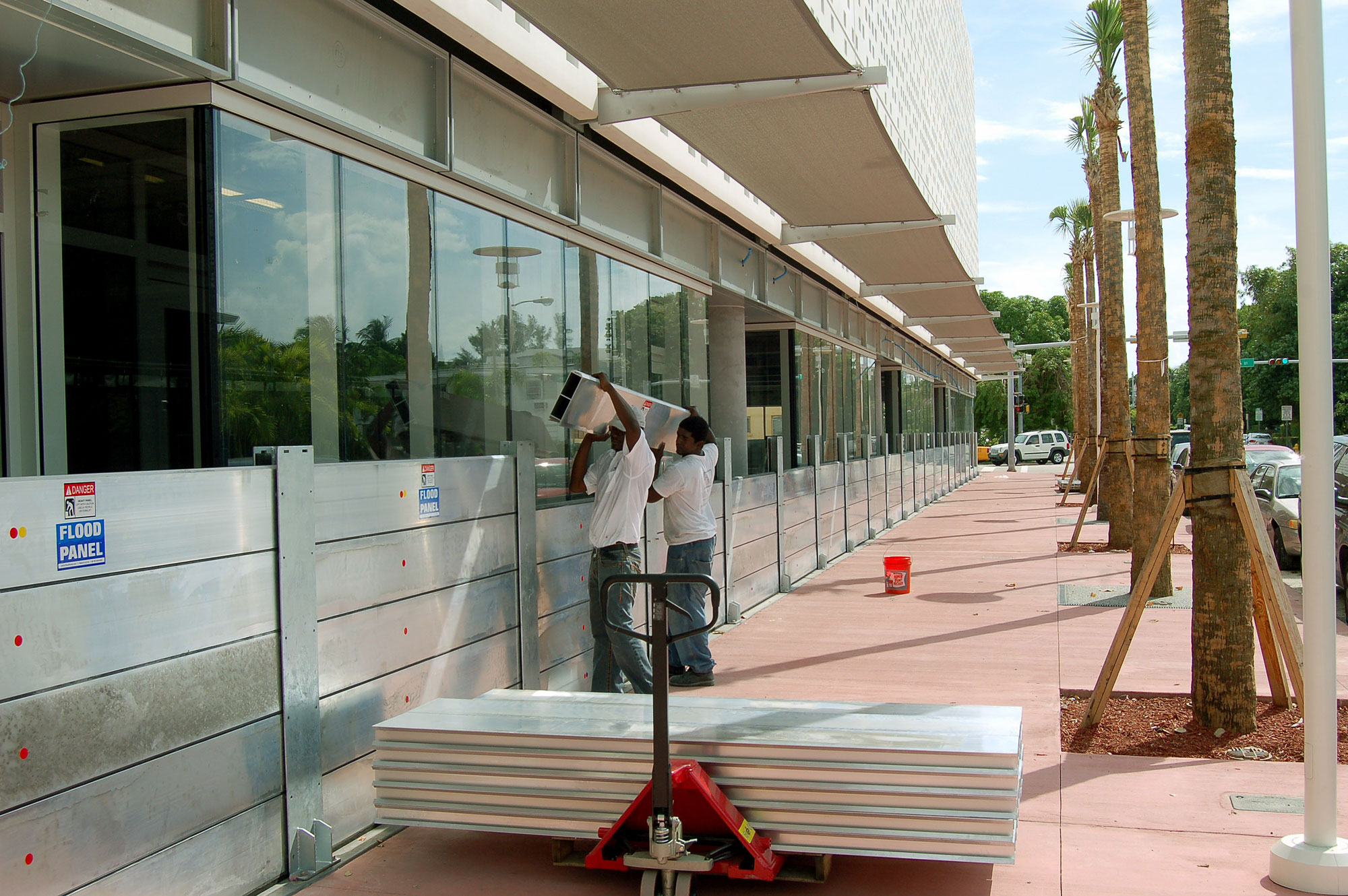Story at a glance:
- Faced with climate change and rising sea levels, Flood Panel steps in to offer education and protection
- Between 2010 and 2014 the average commercial flood claim was $89,000; nearly 25% of businesses were permanently closed following a flood.
Imagine facing the prospect of a flood. Now imagine facing that prospect every few days. Soon it won’t take much twisting of the imagination. New research by Climate Central indicates that by 2045 coastal flooding from the Gulf of Mexico to the Northeast could occur three times a week. If coastal communities fail to adapt to climate change, heavy future impacts from rising seas are certain.
It’s time we brace ourselves. Literally.
“Climate change is on a lot of designers’ radars,” says Lisa Switkin, landscape architect and co-principal of James Corner Field Operations, adding that some municipalities are already changing the way they respond to natural disasters. She sees a shift in urban planning toward designing for longevity, while building professionals are evaluating projects in terms of how they will be able to withstand heavy rain or floods. “Already there are requirements in terms of lifting ground levels to get things out of that flood elevation level of the 100-year flood. That’s the requirement, but I think a lot of people are taking it a step further and thinking about ways they can begin to showcase both sustainability and smart design.”
Whether preparing for a superstorm or taking precautions against so-called nuisance flooding, resiliency is critical. That’s where Tom Osborne comes in. His company, Flood Panel, designs and manufactures commercial-grade flood-proof panels and doors that should be part of every building professional’s flood protection arsenal.

Flood Panel offers the most comprehensive line of flood barriers, flood doors, and flood systems on the market. Photo courtesy of Flood Panel
Preparing for the Storm
Osborne and the Flood Panel management team have nearly 30 years of collective experience in building construction and flood mitigation. Today, Florida-based Flood Panel, established in 2008, provides the most comprehensive line of flood barriers, flood doors, and flood systems on the market. Creators of the first dry floodproofing training courses, Flood Panel has assembled a nationwide network of qualified flood experts that includes architects, engineers, and contractors trained in the most up-to-date systems, codes, and requirements. Company products include modular barrier systems, solid removable panel and post systems, single- or double-door shields, hinged floodgates, Puddle Panels, and customized systems.
While what you need to be prepared for flooding is changing, strength and weight remain key design considerations for products like flood shields. Flood Panel barrier systems are made of extruded aluminum alloy filled with polyurethane elastomer—materials that allow them to resist the pressures of a deluge while remaining physically light enough to store and move in accordance with OSHA safety standards.
In response to rising seas and fluctuating flood maps, Osborne says some municipalities have modified their local code requirements to include higher freeboard, or the height above the recorded high-water mark of a structure. “Miami Beach is already doing this, as are a lot of coastal areas around the country,” he says. “They’re looking at the studies and saying, ‘We believe the water is going to rise significantly in a short period of time, so we’re going to change the codes proactively instead of reactively.’”
Osborne urges anyone who plans to build in flood-prone communities to contact their local building department officials for guidance. Understanding building codes and floodplain management requirements are the first line of defense. Then it’s time to get familiar with flood insurance rate maps, flood boundary maps, flood insurance studies, FEMA technical bulletins, and state and local land use regulations.
To further help people navigate the pre-flood depths, Osborne offers some lessons of his own.
Knowledge is Power
Osborne developed three one-hour AIA-certified seminars to help building professionals better understand flood mediation, from commercial building requirements to flood maps to installing flood safety systems. “The reason we developed the seminars is that we would get calls every day from engineering departments, architectural firms, and developers asking the same questions,” he says. “It’s not just the openings that you need to protect—you have to make sure the entire building can float.”

Federal agencies may have underestimated 100-year flood levels by as much as five feet, according to a study from Washington University in St. Louis. The projected high-water mark for a 100-year flood event on the Mississippi River in St. Louis, for example, is 51.5 feet—21 feet above flood stage. Washington, D.C., and Annapolis, Maryland, could see more than 120 high-tide floods every year by 2045—that’s one flood every three days. Photo courtesy of Flood Panel
Seminar participants take home signed flood certificates, which are required to participate in the National Insurance Flood Program for dry floodproofing. “At least 90% of the people we talk to over the phone don’t even know what that certificate is,” Osborne says. “Those certificates are signed by an architect or an engineer, indicating an expert has looked at the project drawings, evaluated the structure, and [confirmed] the design and structure are in accordance with accepted standards.”
Graduates of the seminar series may join a national network of partners that includes engineers, architects, and floodplain consultants. “If they’ve taken our seminars and keep up with the continuing education we provide, we consider them flood mitigation experts,” Osborne says. “We’ve become a resource. That’s what really drives the company.”
Osborne says education is key to resiliency. Beyond buying and installing barriers, building professionals must invest time and energy to understand what it takes to be protected in the age of climate change. Flood Panel’s commitment is evident. “I want to get structural engineers, architects, contractors, construction professionals, and commercial building owners involved in our network so we have knowledgeable industry leaders to call for flood mediation and protection.”

